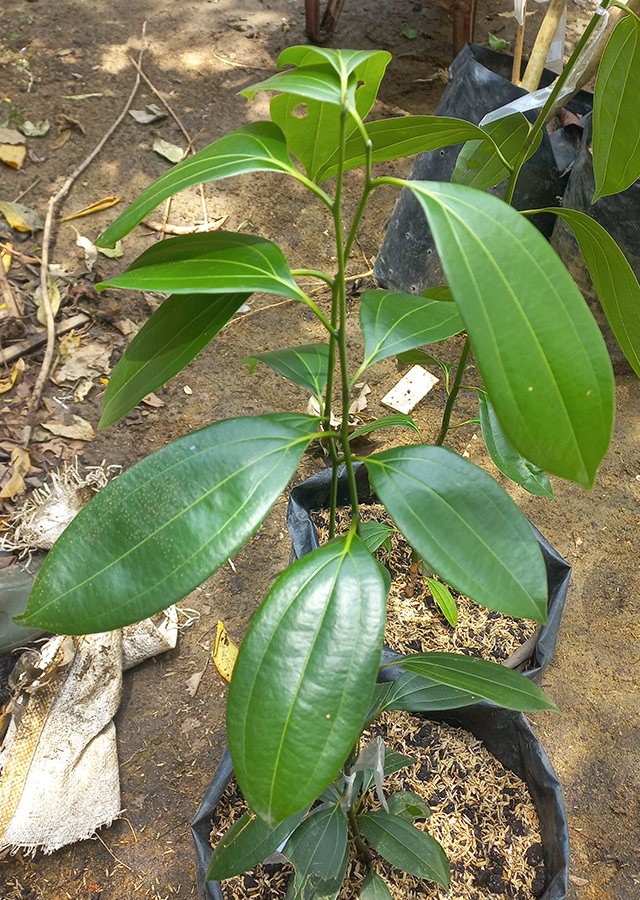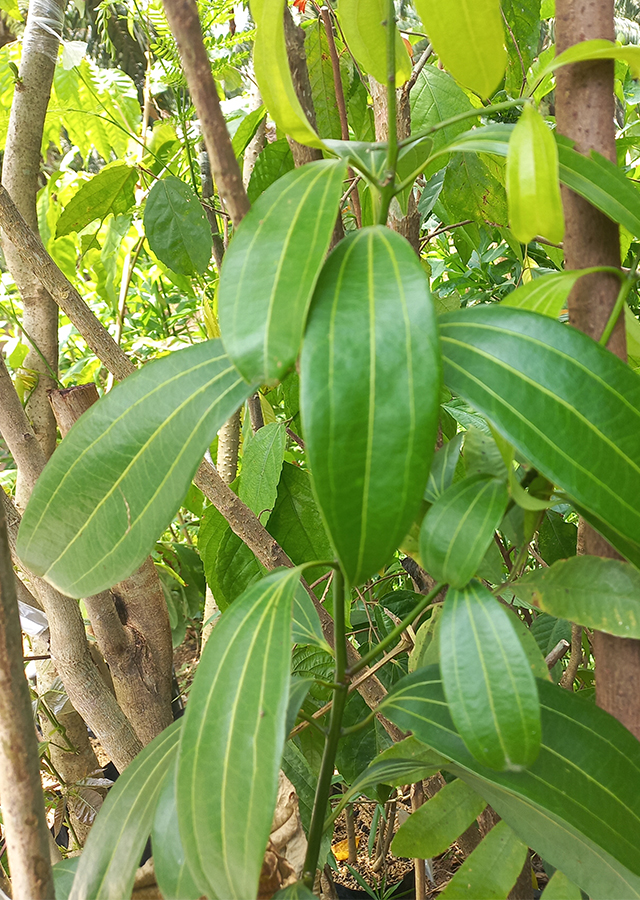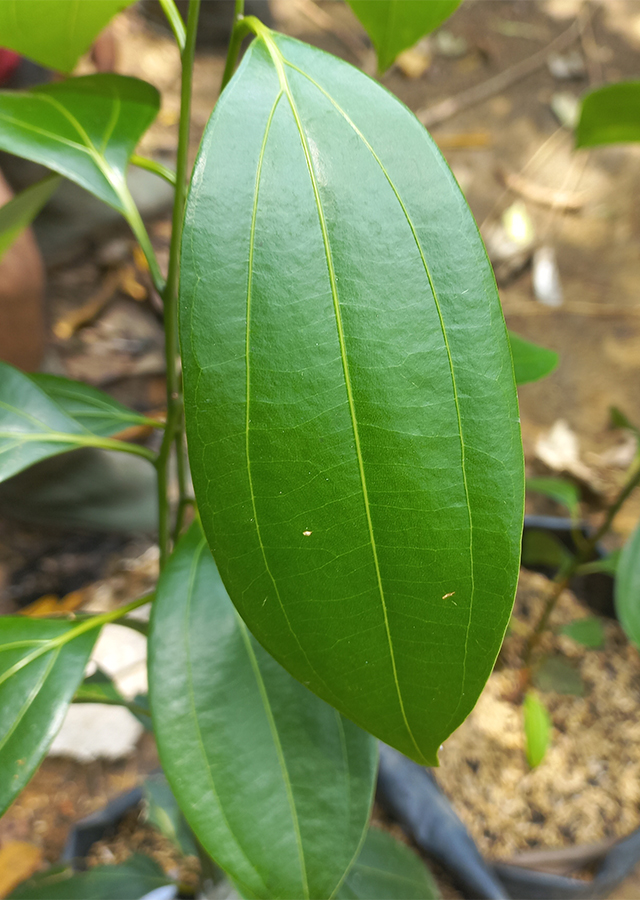Chinese Cinnamon
Neolitsea cassia (L.) Kosterm.
Lauraceae
Location in our garden
Principal



Synonym
Balanopsis cassia (L.) Raf.
Camphorina cassia (L.) Farw.
Cinnamomum cassia (L.) J.Presl
Habitus
Trees. An evergreen perennial tree growing up to 20 m tall.
Part Used
Bark
Growing Requirements
Full Sunshine
Need Shade
Habitat
Forest
Coastal
Roadside
Overview
This species is native to Sri Lanka. One of the earliest recorded spices, being used in China almost 5,000 years ago. The dried bark is the source of the important spice cassia. Both the bark, and an essential oil derived from it, are used as a flavouring in various foods such as curries, confectionery, baked goods, chewing gum etc. An essential oil distilled from the leaves is used as a food flavouring in soft drinks, sweets etc. Extracts of the leaves, wood, bark etc are used in commercial cosmetic preparations as perfumes. The dried and powdered bark is used in commercial cosmetic preparations as a skin conditioner, hair conditioner, for oral care etc. The wood is used for making furniture, sawing boards, implements etc. It is widely cultivated as a spice crop in much of eastern Asia.
Vernacular Names
No found data on this. Need further research.
Agroecology
Neolitsea cassia is a plant of the lowland tropics and subtropics, where it is found at elevations up to 500 metres. It grows best in areas where annual daytime temperatures are within the range 15-32 °C, but can tolerate 10-38 °C. It grows most commonly along the coast, and sometimes in inland forest, and limestone areas up to 1,000 m altitude. It prefers a mean annual rainfall in the range 1,100-1,500 mm, but tolerates 900-3,000 mm. Dormant plants can be killed by temperatures of -6 °C or lower, whilst young growth can be damaged at -2 °C. Prefers a fertile, sandy, moisture-retentive but freely draining soil in full sun or partial shade, with a pH in the range 5-5.5, tolerating 4.5-7.
Morphology
- Stem - the straight, cylindrical bole can be up to 70 cm in diameter.
- Leaves - its stalked, alternate leaves are oval to oblong in shape, 7-11 by 2.4-4 cm, with three distinct nerves from the base. Young leaves are pubescent.
- Flowers - its tiny flowers develop in greenish, almost stalkless flower-heads that are 9 mm-wide at the leaf axils.
- Fruits - round fleshy, simple fruits are 6-7 mm wide, turning reddish then black when ripe.
Cultivation
- Generative propagation is by seed - the seed has a short viability and is best sown as soon in containers as it is ripe. Remove the fruit pulp since this can inhibit germination. Soaking the seeds for 24 hours in lukewarm water hastens germination. Germination can take 1-6 months at 20 °C. The germination rate of fresh seed is about 50%, falling to 25% for seed 6 months old, and zero for those 1 year old. Stored seed should be sown as soon as possible in containers. When they are large enough to handle, prick the seedlings out into individual pots and plant them out into their permanent positions when 10 cm or more tall.
- Vegetative propagation is by cuttings of semi-ripe side shoots, 7 cm with a heel, in a frame with bottom heat.
Chemical Constituents
One new sesquiterpene dilactone (coccinine), one new β-carboline alkaloid (daibucarboline F), linderane, linderalactone, pseudoneolinderane, linderanlide C, linderanine A, epicatechin, taxifolin, astilbin, L-quercitrin, and afzelin.
Traditional Medicinal Uses
- The bark is a pungent, sweet, hot herb that stimulates the circulatory system, improves digestion, relieves spasms and vomiting and controls infection, antibacterial. respiratory stimulant, stomachic, tonic and uterotonic.The inner bark is used in Western herbalism in preparations to treat digestive problems such as diarrhoea, flatulent dyspepsia and colic, as well as colds.
- In the Orient it is used to treat diarrhoea, poor appetite, low vitality, kidney weakness, rheumatism and coldness.
Part Used
Reference Sources
- Fern, Ken. (2021). Useful Tropical Plants: (Redirected from Neolitsea cassia) Cinnamomum cassia. http://tropical.theferns.info/viewtropical.php?id=Cinnamomum+cassia&redir=Neolitsea+cassia. 09-12-2021.
- Jani, N.A., Sirat, H.M., Ahmad, F., Aminudin. N.I. (2021). New sesquiterpene dilactone and β-carboline alkaloid and the α-glucosidase inhibitory activity of selected phytochemicals from Neolitsea cassia (L.) Kosterm. https://www.tandfonline.com/doi/full/10.1080/14786419.2021.1961134. 09-12-2021.
- Kew Royal Botanic Gardens. (2017). Plant of the World Online: Neolitsea cassia (L.) Kosterm.. http://www.plantsoftheworldonline.org/taxon/urn:lsid:ipni.org:names:466940-1. 09-12-2021.
- National Park of Singapore. (2021). Flora Fauna Web: Neolitsea cassia (L.) Kosterm.. https://www.nparks.gov.sg/FloraFaunaWeb/Flora/3/2/3261. 09-12-2021.
